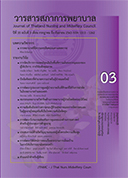Development of Instructional Video for Home Visits as Part of Family Health Services
Keywords:
development of an instructional video, home visits, family health servicesAbstract
Abstract:
Objective: To study an instructional video for home visits as part of family health services, as well as its impact on experts’ opinions, the effciency of the instructional video, and nursing students’ knowledge and opinions.
Design: Developmental research.
Methodology: The subjects, recruited by means of simple random sampling, consisted of 80 fourth-year nursing majors of the Faculty of Nursing, Chiang Mai University, in the academic year 2019. The research instruments consisted of an instructional video, an expert opinion survey form, a knowledge quiz form, and an opinion survey form for nursing students. The data were analysed using descriptive statistics and T-test statistics.
Results: Firstly, the experts were in the highest agreement on the quality of the instructional video. Secondly, the effciency of the instructional video (E1/E2) was at 73.82/89.78, where E1 meant ‘below the benchmark’ and E2 meant over the pre-determined benchmark of 75/75. Thirdly, the subjects’ average post-experimental score was signifcantly higher than their pre-experimental score (p < .001). Finally, the subjects displayed high overall satisfaction with the instructional video.
Recommendations: The fndings showed that the instructional video for home visits as part of family health services effectively enhanced the students’ knowledge and satisfaction with the medium. It is recommended that this video medium be applied to courses or training programmes on family health services to increase nursing students’, nurses’, and healthcare professionals’ knowledge.
Downloads
References
Chiang Mai University. Faculty of Nursing. Department of Public Health Nursing. Manual of course 551392:
Community Nursing Practice. Chiang Mai: Chiang Mai University: Faculty of Nursing; 2018.
Narin R. Helping care for patients at home. Chiang Mai: Siam pim nana; 2018.
Eysenck JJ, Arnold W, Meili R. Encyclopedia of psychology. London: Search Press Limited; 2000.
Chiang Mai University. New learning management pilot project that is consistent with the century 21:
academic years 2017 [Internet]. 2018 [cited 2019 Jun 19]. Available from: https://m.facebook.com/
permalink.php?story_fbid=689587244558481& id=185046188345925
Kunaviktikul W. Teaching and learning in the discipline of Nursing in the 21st century. Nurs J [Internet]. 2015
Apr/Jun [cited 2019 Jun 16]; 42: 152-156. Available from: https://www.tci-thaijo.org/ index. php/cmunursing/article/download/39439/32625
Yodchai K, Oumtanee A, Sangkharak W. The effects of using karaoke videotape of nursing care for cardiovascular disease patients on knowledge of nursing students, Faculty of Nursing, Prince of Songkla University. Songkla Med J [Internet]. 2007[cited Jun 17]; 25:531-536. Available from:
h t t p : / / m e d i n f o . p s u . a c . t h / s m j 2 / 2 5 _ 6 /pdf25.6/07Yodchai.pdf
MaMom J. Outcomes of computer-mediated review lesson on pressure-sore dressing as observed in
second-year nursing students’ knowledge, practical skills and opinions. TJONC 2012;27:63-76.
Sangkasatechai P. Development of the e-learning courseware media of MTH102: Daily food and
diseases. JRSU [internet]. 2013 [cited 2019 May 25]; 7:31-40. Available from: https://jrtl.rsu.
ac.th/ volume/7/number/1/article/94
Limapongpas B, Kokilanan K, Thitipaisan N, Sirisakulveroj M. Effects of preoperative instruction using multimedia in patients receiving spinal anesthesia. JHSR 2015;9:9-11.
Nakanakupt M, Iamchareon T. Development of video media on childbirth for third-years nursing
students, Rangsit University. RSU National Research Conference [Internet]. 2017 [cited 2019 Apr 11]:1343-1353. Available from: https://bit.ly/2wUyDBG
Jungpanich A, Sritailaun A. Effects of using daily care plan video teaching on clinical self-confdence
and satisfaction of nursing students, Kuakarun Faculty of Nursing, Navamindradhiraj University. Kuakarun
J Nurs [internet]. 2015 [cited 2019 Apr 4]; 22:17-32. Available from: https://he01.tci-thaijo.org/index. php/kcn/article/view/46653
Pornkul C. Teaching design. 2nd ed. Bangkok: Chulalongkorn University; 2011.
Shyles L. The art of video production. United States: Sage publication; 2007
Bloom BS. Taxonomy of education objective: cognitive domain. New York: David Mckey; 1964
Krejcie RV, Morgan DW. Determining sample size for research activities. EPM 1970;30:607-610.
Rovinelli RJ, Hambleton RK. On the use of content specialist in the assessment of criterion-referenced
test item validity. Dutch J Edu 1977;2:49-60.
Srisaard B. Preliminary Research. 7th ed. Bangkok: Suviriyasat; 2002.
Yamkasikorn M. How to use effciency criterion in media research and development: The difference
between 90/90 standard and E1/E2. J Edu 2007;19:1-16.
Brahmawong C. Teaching media system: Testing of media effciency or teaching package. Bangkok:
Chulalongkorn University; 1977.
Likert R. The method of constructing and attitude scale: Reading in attitude theory and measurement.
New York: Wiley & Son; 1967.
Grant J, Davis L. Selection and use of content experts for instrument development. RINAH 1997;20:
-274.
Kuder GF, Richardson MW. The theory of the estimation of test reliability. Psychometrika 1937;2:151-160.
Bloom BS. Taxanomy of educational objectives, the classifcation of educational Goal-Handbook I:
Cognitive domain. New York: Longman; 1979.
Cronbach LJ. Essential of psychology and education. New York: Mc–Graw Hill; 1984.
Fongsri P. Research in class: Principle and practical techniques. 2nd ed. Bangkok: Pimngam; 2006.
Mansiri P. Handout for communication language: language for communication. Loei: Loei Rajabhat
University; 2013.
Department of Academic Affairs. Basic education course. 2nd ed. Bangkok: Counting and delivery
organization; 2018.
Sanongdej W, Wangpitipanit S, Chonsin P, Chalermpichai T. Development and effect of video
media combined with scenario on knowledge and self-confdence in practice of occupational health
nursing for nursing students. Rama Nurs J [Internet]. 2018 [cited Jun 17]; 24:94-107. Available
from:https:// he02.tci-thaijo.org/index.php/RNJ/article/view/62234








